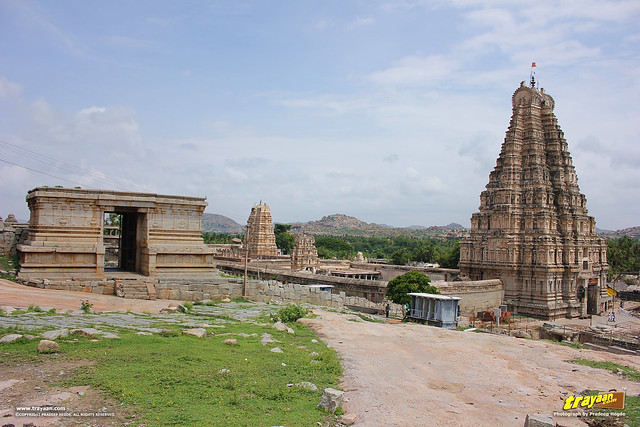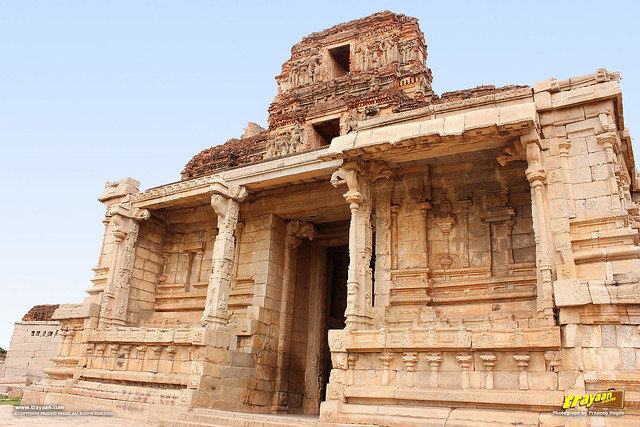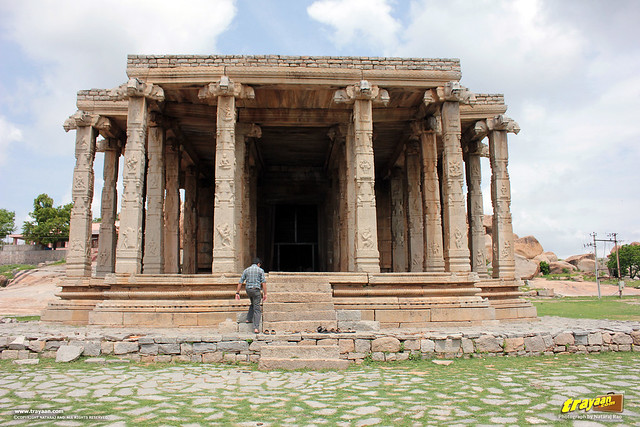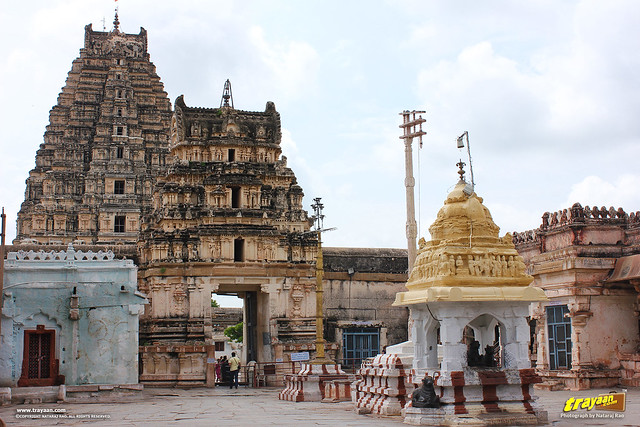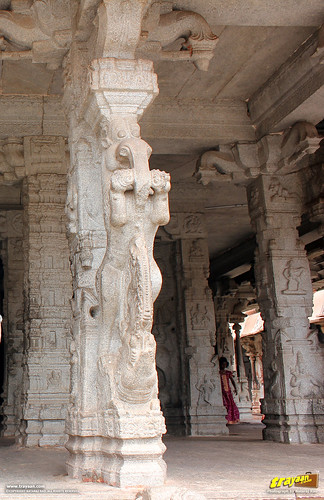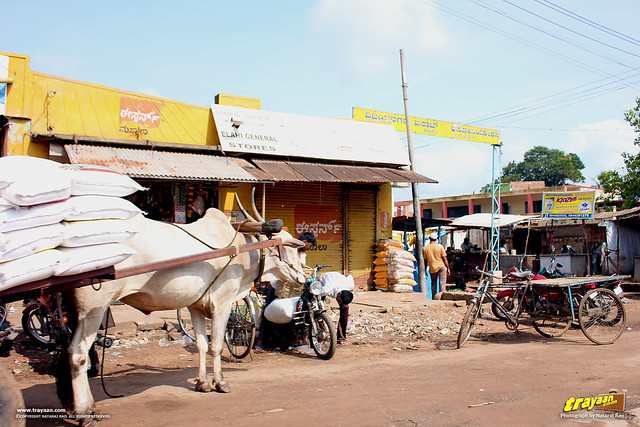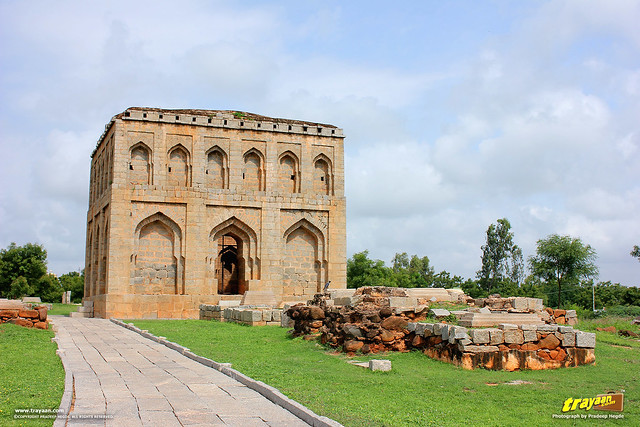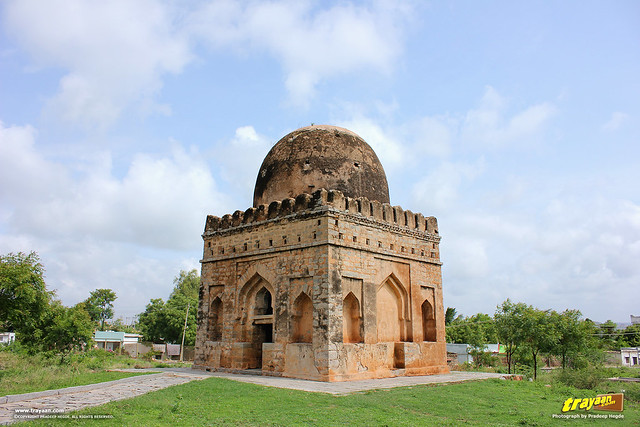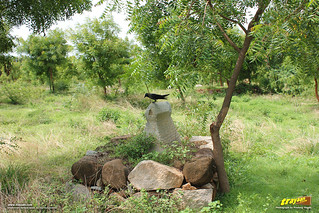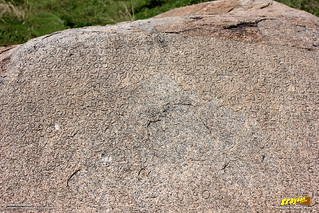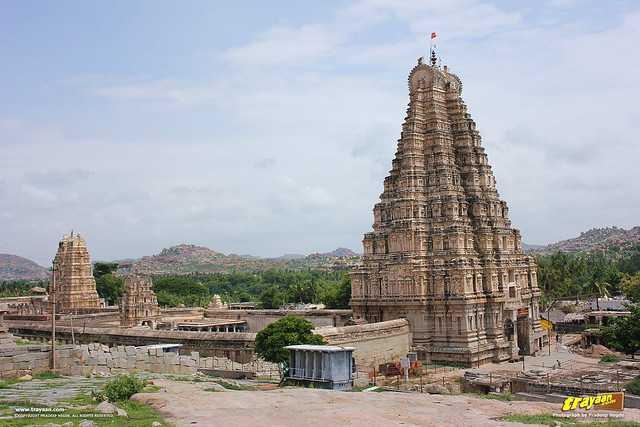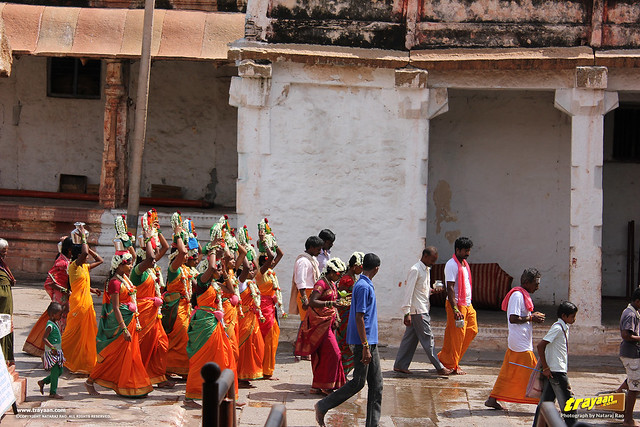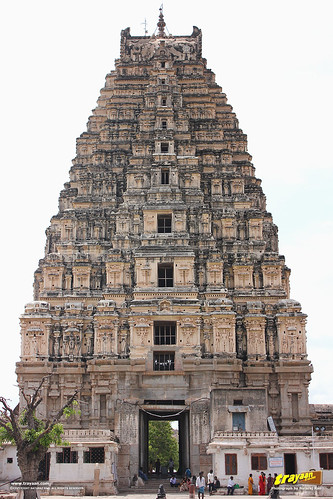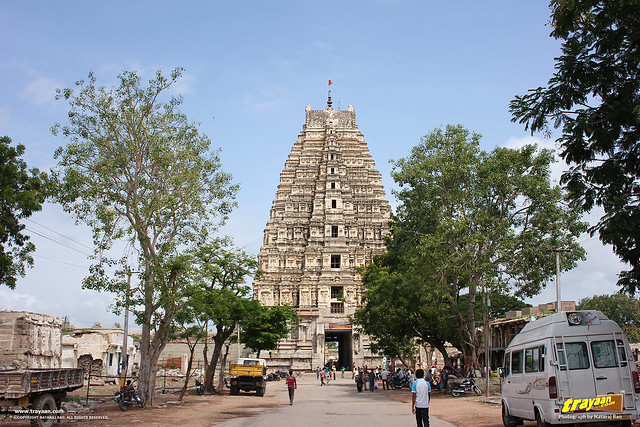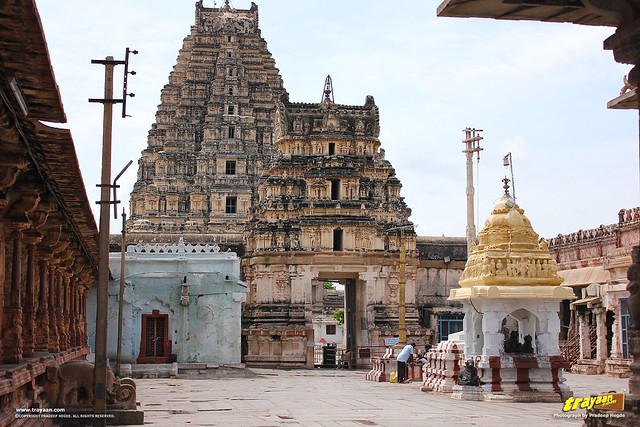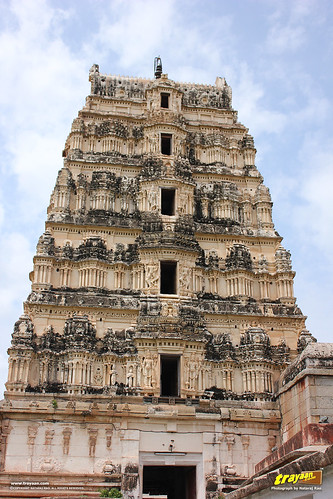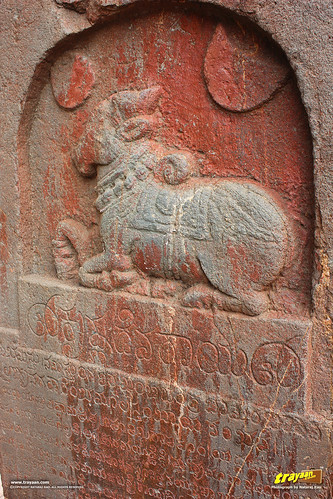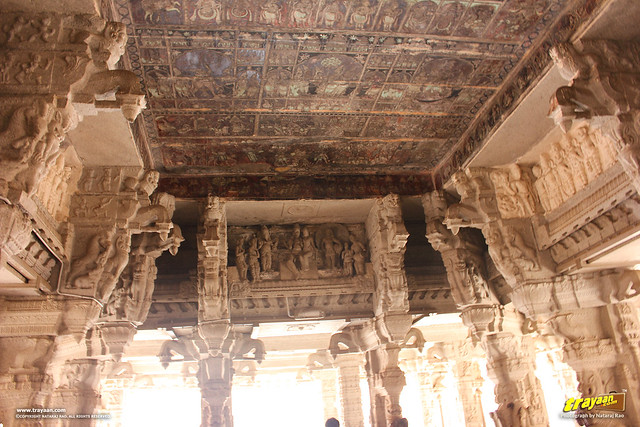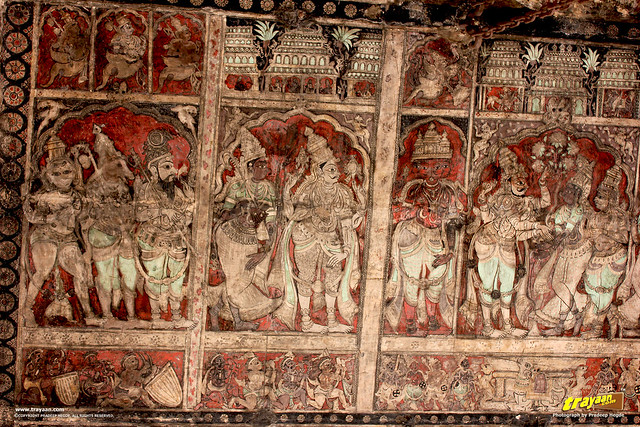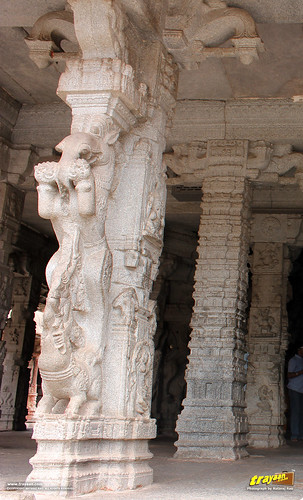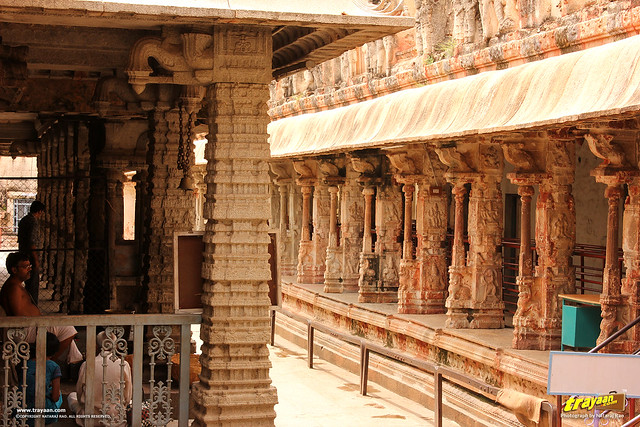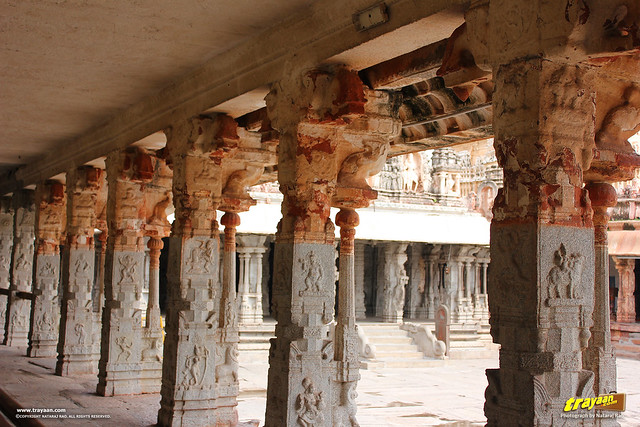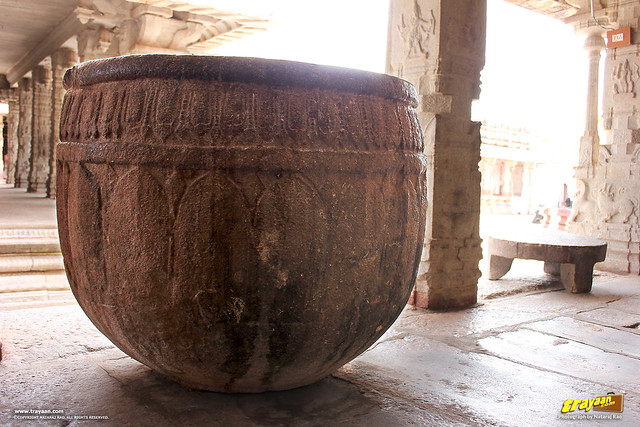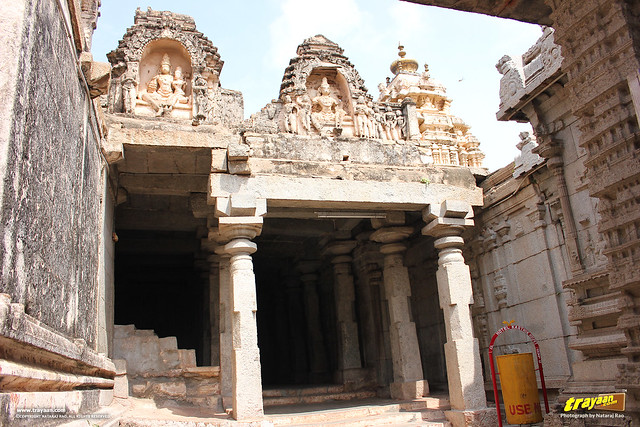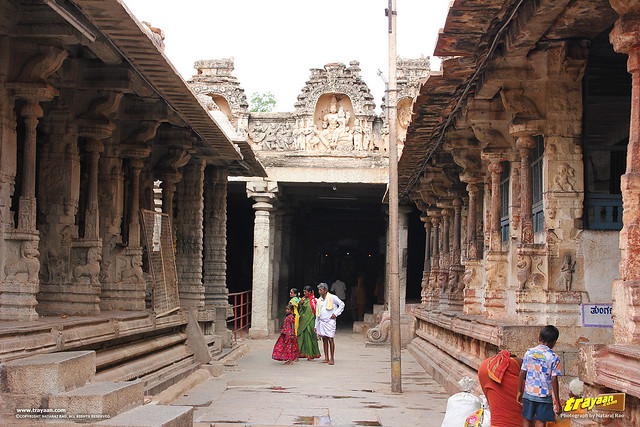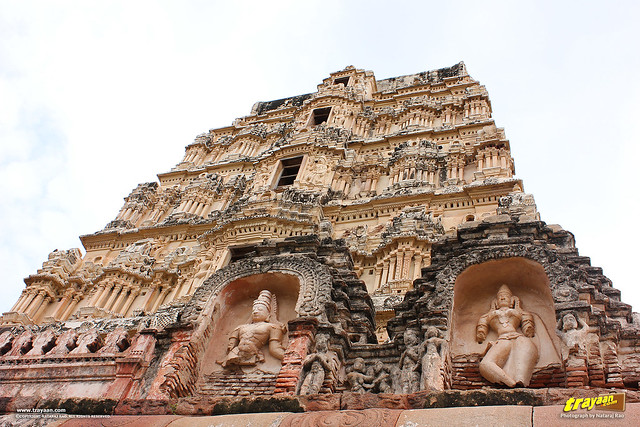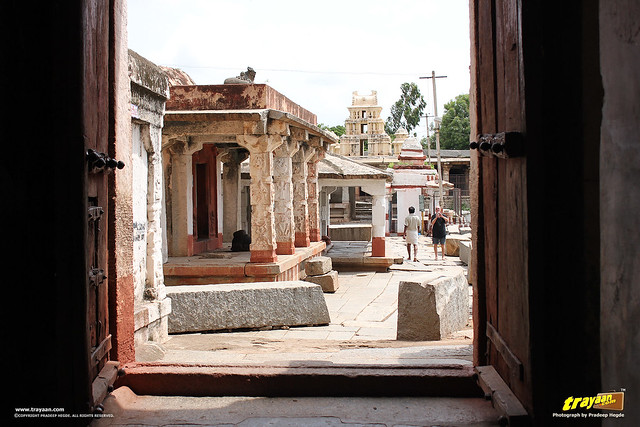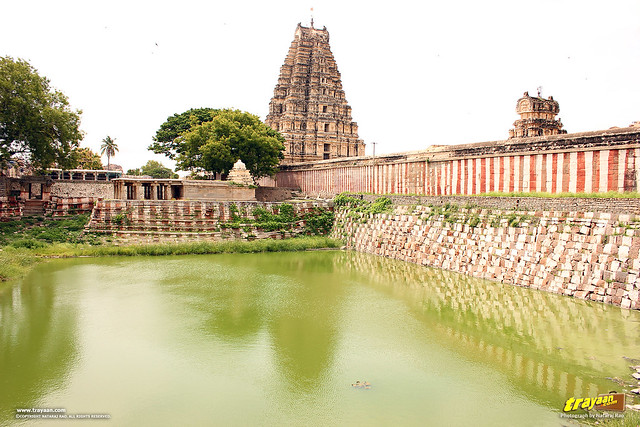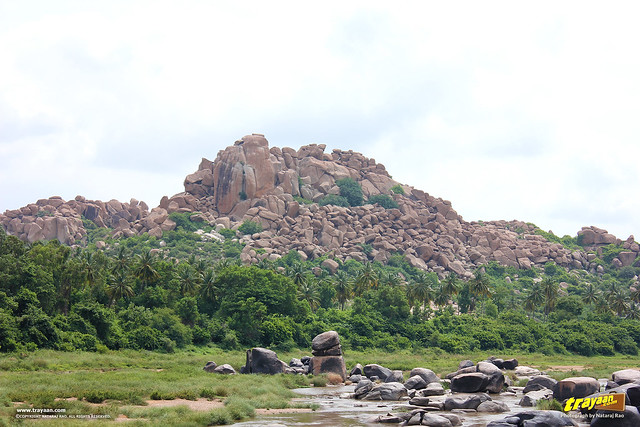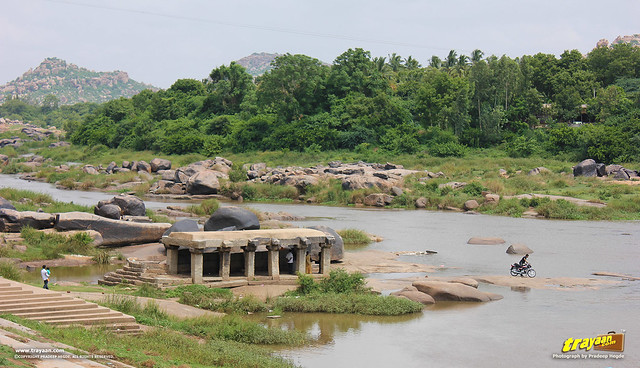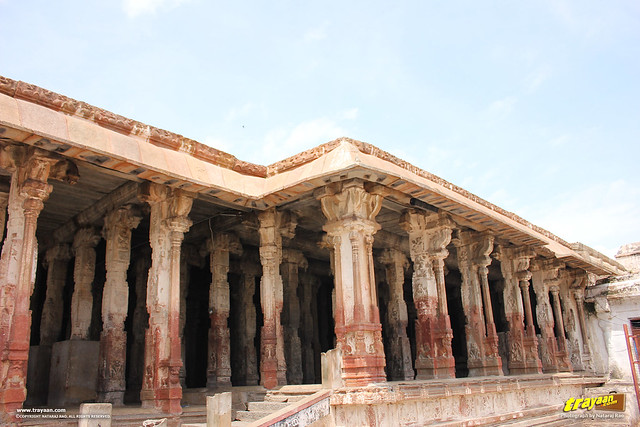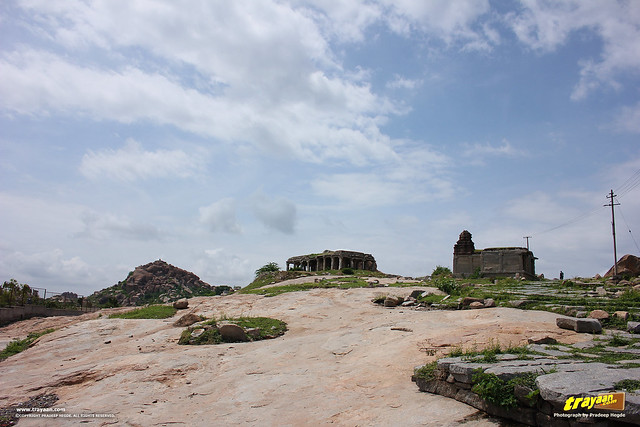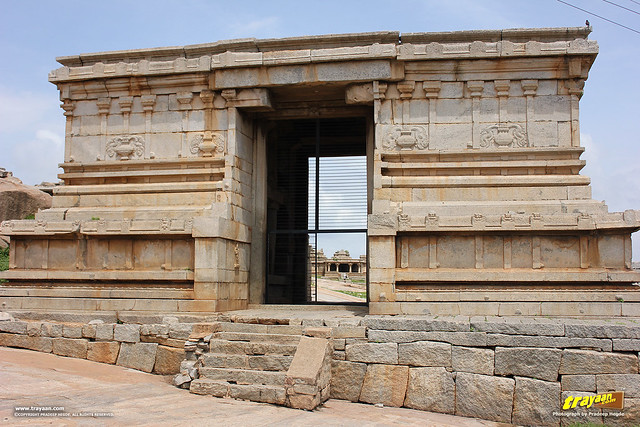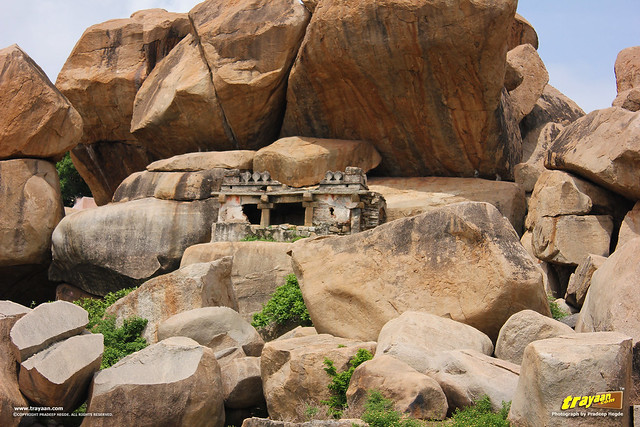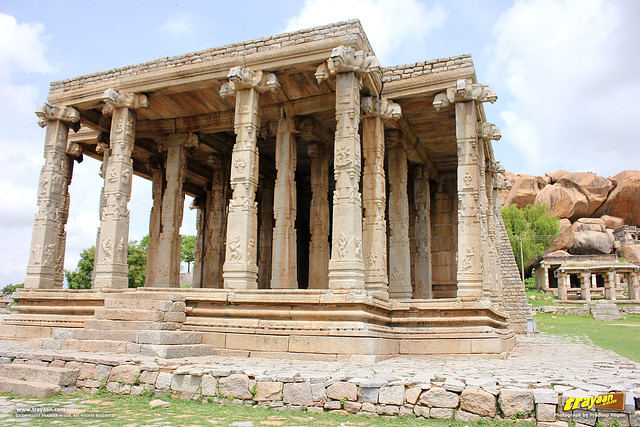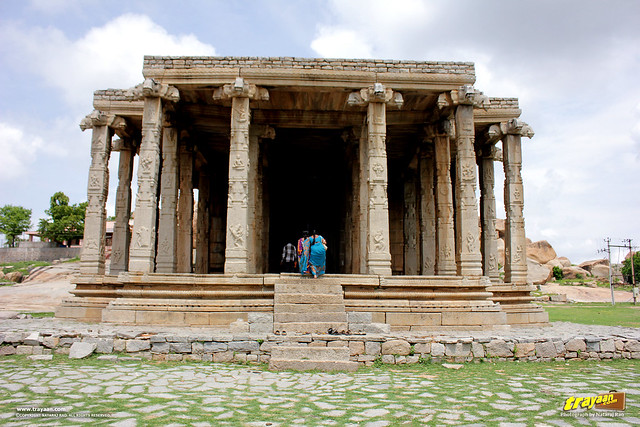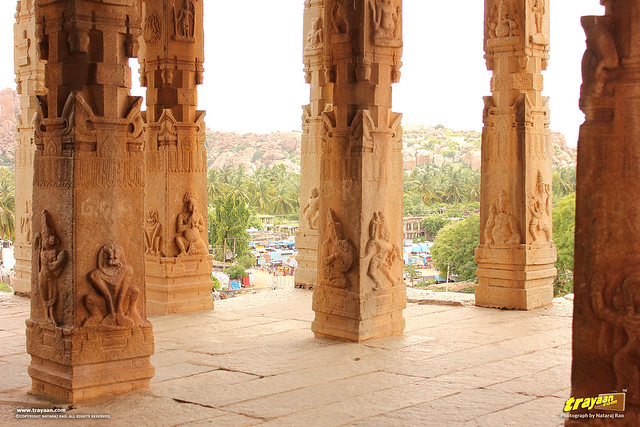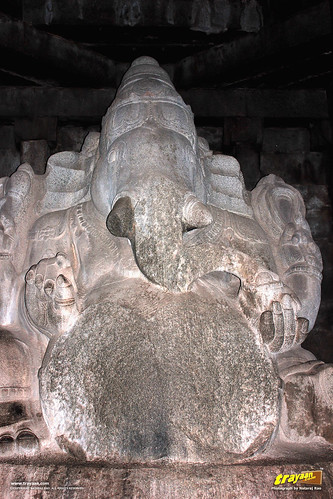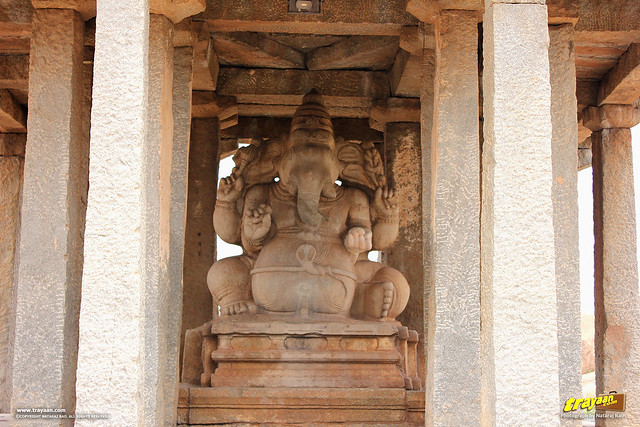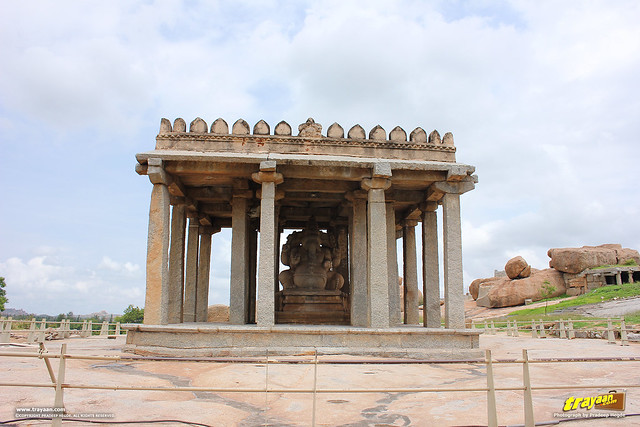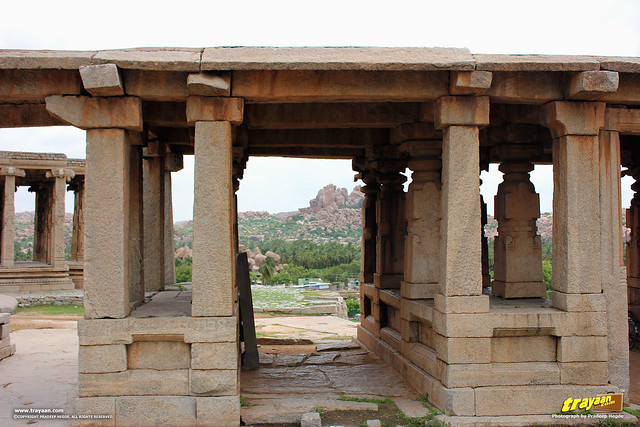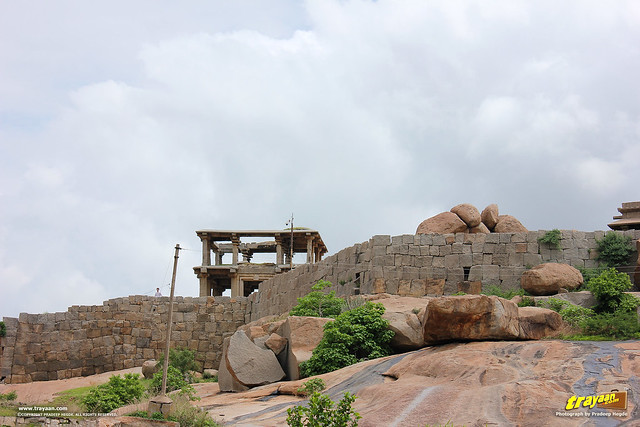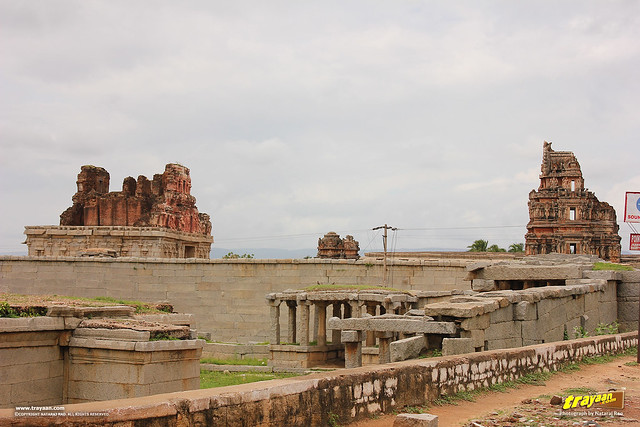Part 1 – Shri Virupaksha temple, Hemakuta hill and other surrounding monuments at Hampi, a World Heritage site in Karnataka.
Hampi, the famous world heritage site houses the monuments and ruins of the magnificent historical capital city Vijayanagara (or Vijayanagar), of the glorious empire that is referred to with the same name.
Here is the first part of our Hampi travel story series, which includes the famous Virupaksha temple, Hemakuta hill, Kadlekalu and Sasivekalu Ganesha monoliths; and more, along with handy maps and tips.
Trip to Hampi – Part 1The ruins of Vijayanagar, in and around Hampi, formerly in Bellary district (later renamed as Ballari), is one of the most visited destinations in Karnataka. Declared as a world heritage site by UNESCO in 1986, these group of monuments spanning an area of about 26 square kilometres, numbering more than thousands of standing and partly ruined structures, exist today as the remains of this glorious and large medieval capital city of India
Update (Monday, 08 February 2021): A new Vijayanagara district was carved out of Ballari district as per an official gazette notification of Karnataka government. Hampi and the ruins of the erstwhile grandiose city of Vijayanagara now belong this new district which is named after it.[12]
In this five part series of our Hampi Trip, we take you through the must see places to visit in Hampi, along with some information about these world heritage monuments.
| Place Details | Brief History of Vijayanagara | Vijayanagara style of temple architecture
| Our Hampi Trip (Part 1)
| Virupaksha Temple and Hampi Bazaar
| Hemakuta Hill and temples
| Kadlekalu Ganesha monolith | Sasivekalu Ganesha monolith
| Tips for Travellers | Getting There & Transportation | Best times to visit
| Location Map - Places to see in & around Hampi | Get Directions
Brief History of Hampi and Vijayanagara
Before we begin, let us take a short dive into the history of Vijayanagara and the significance of this world heritage site.Vijayanagara Empire, established during 14th century somewhere between 1335 to 1347 CE by brothers Harihara raya I and Bukka raya I of Sangama dynasty, popularly known as Hakka and Bukka, on the word of their guru Sri Vidyaranya who headed the Sringeri Sharada peetha from 1331 CE to 1386 CE, to hold back the Muslim invaders from the north. Some historians refute this religious view, but yet, it is agreed upon that Vijayanagar empire was the last great Hindu kingdom of India.
The empire is named after its great capital city Vijayanagara, meaning the city of victory. This empire which prospered between 14th and 16th centuries grew into one of the greatest empires covering almost all of southern India during its peak. It is also well documented in inscriptions, and by historians that the empire was referred to and known as “Karnata samrajya” meaning the Karnata Empire.
With Vijayanagara as the glorious capital, it was ruled by three dynasties, the Sangama (1336-1485), the Saluva (1485-1505) and the Tuluva (1505-1570). Krishnadevaraya of the Tuluva dynasty was the greatest emperor under whose time religion, art and architecture began to thrive in an unprecedented scale. The empire’s armies led by him were victorious everywhere they went and the empire and the city grew and prospered.
This glorious and populous city whose striking wealth and prosperity was described in great detail by various foreign travellers and traders during its existence came to a shocking and abrupt end in 1565 CE at the catastrophic battle of Talikota, (~ 180 kms north of Hampi), where the de facto ruler Ramaraya was killed by the united forces of the Deccan Muslim confederacy. Tirumala, his brother escaped with remaining troops to Vijayanagara and fled to Penukonda with royal treasures and the captive namesake emperor Sadashiva.
The great city of Vijayanagar which was thus left undefended was looted and pillaged for six months by the allied forces, leaving it in a partly ruined state.
Vijayanagara was abandoned and forgotten after an unsuccessful attempt of rehabilitation in 1567 CE by Tirumala, who later declared himself as king, called Tirumalaraya of Aravidu dynasty. Under the Aravidus (1570-1646 CE), with capital initially at Penukonda and later Chandragiri further south, the empire grew weak and gradually waned out of existence, during which the city of Vijayanagara crumbled into further ruins. Treasure seekers and vandals further damaged and vandalized the ruined city throughout the ages.
The area around Hampi is known to have been occupied in prehistoric times. Hampi is said to have been Pampakshetra of Kishkinda, the ancient kingdom of the Vānaras (Vānara : monkey-men) of the Indian epic tale Ramayana and the home to Lord Hanuman. There is also a place here called Sugreeva’s cave.
References: [1][2][3][4][5][6]
The Vijayanagara style of temple architecture
The Vidyashankara temple at Sringeri is one of the earliest temples built with the aid of Vijayanagara kings of Sangama dynasty, in around 1338 CE. The 14th and 15th century temples were simpler and much like those of Chalukyas, and incorporated earlier Deccan styles rather than their immediate predecessors, Hoysala or Kakatiya. The Ramachandra (Hazara Rama) temple during Devaraya I was probably the first to incorporate styles of southern Tamil zone, especially the earlier Chola style.But under the Tuluvas, since Krishnadevaraya, larger temples were built showing more influences of Tamil styles, with several older temples which were renovated and extended across the empire; all featuring large beautiful mandapas (mandapa = a large open pillared hall) and tall towering gopuras (gopura = a towered entranceway leading to a walled inner enclosure housing the temple), which became typical features of large Vijayanagara era temples. Several old temples or shrines like the Virupaksha temple at Hampi were extended with mandapa and gopura additions. Temples in Hampi, like Krishna temple and the beautiful Vitthala temple represent later evolved styles in 16th century under the Tuluvas.
The beautifully carved leaping and rearing mythical beasts like yalis on the pillars are the hallmark of mature Vijayanagara architecture.
The large and towering gopura aren’t seen in any of the previous styles of Deccan such as Rashtrakutas, Kadamba, Chalukya, or even in the most ornate Hoysala. The entrance gopura before the Chennakeshava temple in Belur is of Vijayanagara times, whereas the temple itself is of Hoysala period.
Above their granite entrance pathway, gopuras feature ascending storeys built with wood, brick and plaster stucco figures, which are undoubtedly a Vijayanagara inception inspired from the smaller Chola and Pandya gopuras and styles. For example the smaller stone gopuras of Brihadeeshwara temple in Tanjavur (11th century), Airavateswara Temple, Darasuram (12th century); both in Tamil Nadu built during the Chola era.
Vijayanagar temples also began featuring these “Dravidian” dome like peaks ( shikhara) over their main sanctum, instead of the earlier Deccan styled pyramidal peaks of a square base. But instead of stone as in the temples of Tamil zone from which they were inspired, here they were made of brick and plaster. Plaster was used over the brick structure to achieve fine ornamentation and figures.
The Veerabhadra Swamy temple at Lepakshi is one of the several temples that feature this architectural style outside of Vijayanagara.
References: [2][6][7][8]
Our Hampi trip
A Friday evening overlooking a long weekend with nothing to do, we suddenly decide to go to Hampi over a phone conversation. What makes this trip unique is that there were no plans, no bookings, and no idea of how to get around. We only knew that we were going to Hampi. With the trains fully booked, we arrived at the Bengaluru bus stand wondering whether we would get any seats, yet managed to get lower berths in a KSRTC sleeper.After a sleepless overnight journey thanks to a loudly snoring co-passenger, we landed in Hospet bus stand, early morning around 6 am. Hospet (anglicized form of Hosapete meaning New Town in Kannada) was one of the suburbs of Vijayanagara. Hospet is now renamed officially as Hosapete[15]. Now this town doesn’t have any of the structures of that period, except Anantashayana temple in the outskirts by the road leading to Hampi.
With no rooms booked and nothing good to our budget in hotel booking apps even though it was off season in hot and humid June, we started walking down the road. After enquiring a couple of hotels which were full, we were tired and in a mess that early morning. As we randomly stopped by a small shop for some snacks and tea, there was a hotel right in front. Nataraj enquired and came back saying we not only got an accommodation, but also a discount! The manager also had a cab arranged for us to take us around Hampi, with whom we further went to Pattadakal, Badami and Aihole in the coming days. We had gone with zero planning and yet it turned out to be such a wonderful trip.
Hampi is the anglicized name of Hampe, which derives its name from the river Pampa, which is the ancient name of river Tungabhadra. It is believed by the devotees to be the place where their deity lord Virupaksha married the river goddess Pampa.
Mohommadan tombs of Kadiramapura
On the way to the famous Virupaksha temple, we came across these Mohommadan tombs in Kadiramapura. There is a large roofless building in Bahamani Islamic style housing three tombs inside, and a small one with a dome superstructure just behind this building. The larger dargah probably had a roof and even a dome above which might have eventually collapsed, but there is no evidence of that now.Several tombs lie outside in the premises. There is also halegannada (old-kannada) inscriptions on a rock in the premises. Vijayanagara was linguistically and religiously diverse. These monuments and other Indo Islamic Architecture along with the Jain temples of Vijayanagara stand as an evidence of its diversity. The reports of foreign travellers during the era also confirm Vijayanagara being cosmopolitan in nature.
Virupaksha temple of Hampi
We then came to Virupaksha temple nearby the Hemakuta hill.Virupaksha temple dates back to times long before Vijayanagara. A shrine of Virupaksha and Pampa existed here since ancient times. Known to receive patronages of various dynasties since 7th century CE; inscriptions referring to these deities date back to 9th and 10th century CE. This is not only the oldest shrine but also the only major temple in Hampi being well preserved and not in near ruins; with continued patronage, pilgrimage and active worship. In no other major temple among the ruins of Vijayanagara does active worship take place except here.
Major restoration works were done in the 19th century, long after Vijayanagar was destroyed. Worship and religious rituals take place even today. There was continued minimal occupation of the place and continued worship even after the fall of Vijayanagara.[3]
Lord Shiva in the form of Virupaksha, as the consort of river goddess Pampa is the main deity here. Hence the name Pampa pathi is also used for the deity Virupaksha. Pampa was the ancient name of river Tungabhadra that flows adjacent to this temple. This place was known as Pampa kshetra in ancient times and also as Virupaksha pura during Vijayanagar times. Virupaksheshwara temple as it is called now, was also called Pampapathiswami temple.
Remnants of the ruined Hampi bazaar, the stone pavilions and structures can be seen either side of the colonnaded path leading to the temple. A bazaar means a kind of marketplace.
This Hampi bazaar is also the “car street” of the temple where the utsava murthy (festival image) of the deity of this temple will be seated on a ratha or “car”, a kind of chariot pulled and pushed by devotees. These festivities still take place on a designated day every year, but the colonnaded bazaar is abandoned.
In the Vijayanagar times this bazaar was a bustling market and a hub of trade with all kinds of food, birds, animals and even diamonds and precious stones! This is corroborated by writings of Portuguese traders to this place in early 16th century.
You can see such bazaars and car streets before many major temples in India which function even today, even though the street and bazaars may not be as wide or long as the ones at Hampi.
Domingo Paes, a Portuguese horse trader who visited in 1520-22 CE, during the reign of Krishnadevaraya describes this as a very beautiful street with beautiful houses with balconies and arcades which sheltered the pilgrims. He also mentions that the King had a palace in the same street, but there are no traces of this now. His report also mentions a lofty tower (the main east Gopura) and the second smaller gopura. [3] If I may say so, he was one of the great “travel bloggers” of that time! His report is the most detailed one on the glorious city Vijayanagara!
Virupaksha temple’s colossal towered entrance, the 160 foot (~ 50 metres) tall gopura strikingly stands out from the bazaar street. Parts of the temple were restored in the 19th century, including this colossal eastern main gopura (entrance tower). The whole temple is surrounded by high raised walls, cloistered from the inner side.
We went into the temple premises through this towering main gopura in the east. Once entered, this leads into an enclosed area with another gopura, a smaller one, which was originally dedicated by Krishnadevaraya in 1510 CE. Removing the footwear and taking a Rs. 50 ticket for photography, we entered through this second gopura to the east, leading us into the enclosure with the temple.
This inner gopura and the beautiful mandapa (an open pillared hall or pavillion) were dedicated to the temple by Krishnadevaraya on his coronation as king in 1510 CE, making them over 500 years old. There is a stone inscription by Krishnadevaraya before this mandapa of the temple.
The most notable addition of Vijayanagara period to this temple is the front mandapa (an open pillared hall), which is known as Krishnadevaraya’s coronation mandapa. The mandapa has several ornately carved granite pillars with fine patterns and sculptures.
Spectacular Yali columns stand on both sides of the steps to this mandapa, and the inner columns feature beautifully carved lions on some columns, with the yalis and the lions three-dimensionally project out of the pillars. Other columns or pillars are beautifully designed with bas-relief carvings of deities, dancers, and other figures on them along with ornate patterns.
The columns of this mandapa, and other parts of the temple are in good state, but there are some signs of vandalism as there are some disfiguring of the spectacular figures, like for example, on the Yalis carved on two pillars in the front on either sides of the steps, and a lion with a broken paw. These are clear signs of vandalism which probably took place during the great fall of Vijayanagara and the plundering which went on for months by the invading Deccan Muslim forces. As mentioned earlier, major parts of this temple were restored during the restoration works in the 19th century, but some of these broken figures on these granite pillars stand today as a remnant and a reminder of that horrific destruction of this great city.
Curved eaves surround the this front mandapa. Above the mandapa, and also above the pillared cloisters, as we see in the picture, are parapets made of fine brick and plaster stucco sculptures and figures. These brick and plaster parapets are typical Vijayanagar style, as they can be seen mostly above mandapas of temples built during this period, like for example, on the Vitthala temple of Hampi. In some cases traces of these brick and plaster parapets can be found wherever they have been ruined.
The mandapa's ceiling consists of paintings featuring the marriage of Lord Virupaksha to Pampa Devi, the river goddess. However, these fine ceiling paintings we see here today belong to the 19th century restorations, and do not essentially belong to the Vijayanagara period.
The temple sanctum, or the vimana, has a dome-like brick and plaster peak superstructure, or shikhara. This is also undoubtedly an addition to the temple during the Vijayanagara period, along with the extended vimana as we see today and several other additions and extensions to the temple complex. The shikhara has a kalasha, may be of bronze (also called kalash). Kalashsa is a metal jug like cap which is pointed in the top, usually above temple shikharas or peaks of the sanctums (garbha gruha), or vimanas, and over the shala roofs (shala shikharas) of entrance gopuras too.
Most of the temples, big and small, in Vijayanagara feature similar dome shaped shikharas. But they are all depleted of their metallic pinnacles, the kalashas, and partially damaged obviously due to the pillaging that took place after the city was sacked. The Kalasha here is most probably a later addition during restorations.
The temple is surrounded with cloistered corridors with beautifully carved columns, undoubtedly of Vijayanagar times. Some are even painted.
Behind the temple, in a small area, there is a granite wall with a hole which acts as a camera obscura, or a pin hole camera. It makes an upside down image of the colossal eastern temple gopura on the wall opposite to the hole.
There were patronages to this temple in the earlier Chalukya and Hoysala times also. The Bhuvaneshwari shrine, one of the subsidiary shrines surrounding this temple, featuring fine lathe turned pillars typical of the Hoysala and late Chalukya style, is a good example.
We then walked out through the northern gopura, towards the river. This tower known as the Kanakagiri gopura, was renovated in 1830s. This leads to the area with Manmatha tank, a small tank where devotees used to bath and some small shrines. Few structures can be seen on the rocks amidst the river.
Making our way out from the temple through its main east entrance, we climbed the adjacent Hemakuta hill to get a splendid view of the temple and also see the monuments above it. It was around 11 am when we went up the hill under a hot sun and occasional clouds, sweating profusely.
Hemakuta hill
Hemakuta hill, or Hemakoota hill, is a huge granite hill features Rangalingeshwara temple and Jain temples, with a distinct Deccan architectural style, with pyramidal shikharas of a square base. Other attractions on Hemakuta hill are the two monolithic statues of the Hindu Lord Ganapathi, or Ganesha. Kadalekalu Ganesha and sasivekalu ganesha.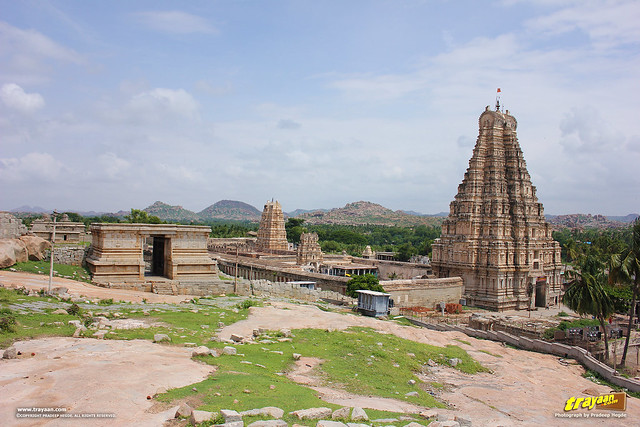
A view of Virupaksha Temple complex and entrance to Hemakuta Temples over the Hemakuta Hill in Hampi
The Kadlekalu Ganesha temple
The Kadlekalu Ganesha temple, made entirely of stone is noteworthy, as it features long monolithic pillars which are not usually seen in Vijayanagara. This is the only temple in Vijayanagara to feature such long columns.Kadalekalu Ganesha is a 4.5 metres high (~14 feet) high monolith, (carved out of a single boulder) of Hindu Lord Ganapathi or Ganesha, whose belly shape resembles the unsplit Bengal gram (Kadale kalu in Kannada), Hence the name Kadlekalu Ganesha. This monolith bears the mark of vandalism as a portion of its belly is cut off.
The top surface of this temple is flat. It probably might have had some parapets with ornamental figures or sculptures made of brick and plaster above like in Virupaksha temple and others, but there are no traces now. It is unknown whether the sanctum had a shikhara (a dome shaped superstructure or a hemispherical peak above the main sanctum) or not.
Sasivekalu Ganesha
Sasivekalu Ganesha is a 2.4 meters high monolith of Lord Ganesha, or Ganapathi, inside a small open mandapa. This shrine features a monolithic image (carved out of a single boulder) of Hindu Lord Ganapathi or Ganesha, whose belly shape resembles the mustard seed (Sasive kalu in Kannada), Hence the name Sasivekalu Ganesha. The Vinayaka mandapa (pavillion) surrounding it was built in 1506 CE by a trader from Chandragiri (near Tirupathi, in Andhra Pradesh), in memory of the king Narasimha II who reigned during 1491-1505 CE, according to a rock inscription nearby.Next, we we headed towards the Krishna temple, nearby and opposite to this hill and then went to the famous monolith of Laxmi Narasimha, which was confused to be Ugra Narasimha, as the Laxmi image seated over the statue is missing. This monolith and a huge monolithic Shiva linga called the Badavilinga are close by Krishna temple complex.
We will return with these and other World Heritage monuments of Vijayanagara in Hampi, in the next part of our Trip.
» Continued in Trip to Hampi – Part 2
Tips for travellers
- All monuments open from Dawn to dusk (Sunrise to Sunset).
- As active worship and rituals take place at Virupaksha temple, footwear is not allowed in the temple courtyard. Granite slabs are paved around the temple premises which can get very hot as the day goes on, so visit here as early as possible. There is a fee of Rs. 50 for photography, which is to take pictures anywhere inside the temple, except the main deity inside the main sanctum. There is no entry fee for any other monuments mentioned in the above post Hampi trip Part 1.
- Beware of the monkeys here, especially on the hills. Avoid them. They are known to snatch away your things and can get quite obnoxious.
- Standing outside the colossal main entrance gopura of the Virupaksha temple, one can also walk down the Hampi bazaar street all the way towards east, to its end, till the mandapa or pavillion with the Nandi monolith (A large monolith sculpture of Nandi the bull, who is the sacred bull of Lord Shiva), at the end of the Hampi bazaar street.
If you don't mind walking a couple of kilometers, at the end of this bazaar street you will find a pathway that leads further eastwards, towards more monuments such as the Tiruvengalanatha or Achyutaraya’s temple (~1.5 kms away) and the famous and artistic Vitthala temple (~2.2 kms away) which features the Stone Chariot. (See details by zooming in the map below).
Also down this path one can access the nearby Matanga Hill and the Virabhadraswamy temple above it once climbed to the top. This will give a splendid view of Hampi and the beautiful landscape around. But one has to be careful while climbing. - You can have a quick look around the significant monuments and places in a day. You need at least two days to have a good look at all those worth seeing here. We made a nice and handy map for you marking most of the things to help you plan and navigate you trip. (Refer to the awesome map below)
Getting there and getting around: Transportation
Hospet town, just ~14kms away from Hampi village is well connected with roadways and railways; with buses from all major places in Karnataka and trains that come from Bangalore, Mysore or Hubli. KSRTC provides sleepers and Volvo buses to Hospet from Bangalore. Hubli is the nearest airhead. Once accommodated in Hospet, you can hire a cab to Hampi which you can enquire your hotel if they can arrange one. There are two wheelers available on rental basis at Hampi, but keep in mind this place gets very hot in summer. Once at Hampi, you can go around in your cab or vehicle, but still you can do a bit of walking also if you don’t mind the scorching sun.Best times of Visit
This is known to be a hot place. At summer temperatures rise above 40 degrees C. We were there in June, during the hot and humid times, and we bore the brunt of the intense heat. Its best to visit during winter, October to February.Location Map - Places to see in and around Hampi
We went there completely unplanned, without a map but you don’t have to! We have marked almost all the monuments of significance in the above map for your convenience, including nearby Hospet and Anegondi.Zoom in for more detailed views and zoom out for more places around. Or, View larger map in new window. Let us know if we missed something or if there is a mistake!
Note: Vijayanagara may also be seen spelled with alernate spellings such as Vijayanagar or Vijaynagar.
References and External links for further reading:
[2] "The New Cambridge History of India I -2 Vijayanagara" by Burton Stein (1989). Cambridge University Press. ISBN 978-0-521-26693-2
[3] "Hampi Vijayanagar" by John M Fritz & George Mitchell, 2015 Jaico publishing house, ISBN 978-81-8495-602-3
[4] Group of Monuments at Hampi - UNESCO World Heritage Centre
[5] Group of Monuments at Hampi, Karnataka - Archaeological Survey of India
[6] "Sculpture at Vijayanagara,Iconography and Style" - Dallapiccola, AL & Verghese, A, 1998 VRP Monograph 6, Manohar, New Delhi.
[7] "The New Cambridge History of India I : 6 Architecture and art of Southern India - Vijayanagara and the successor states" by George Michell, Cambridge University Press, 2008 ISBN 0 521 61925 4, ISBN 0 521 26693 9
[8] New Light on Hampi: Recent Research at Vijayanagara by John M. Fritz, George Michell, Clare Arni, National Centre for the Performing Arts (India), Marg Publications, 2001 ISBN 818502653X, 9788185026534
[9] Vijayanagara Research Project::Suburban settlements
[10] Vijayanagara Research Project::Virupaksha temple
[11] Virupaksha Temple And Bazaar, Hampi | ASI Hampi Mini Circle
[12] Karnataka gets 31st district; govt issues notification carving Vijayanagara out of Ballari - The New Indian Express, Published: 08th February 2021 07:27 PM | Last Updated: 08th February 2021 07:27 PM.
External links for further reading and information:
→ Destination Hampi – Incredible India, Department of Tourism, India
→ Hampi – Karnataka Tourism, Government of Karnataka
→ Good morning, Bengaluru - The Hindu (Changed names of places in Karnataka)


